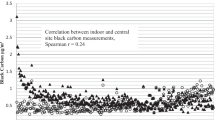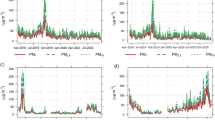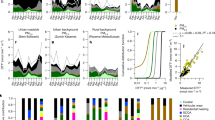Abstract
Fine particle mass (PM2.5), black smoke (BS) and particle number concentration (NC) were measured simultaneously indoors and outdoors at an urban location in Erfurt, Germany. Measurements were conducted during 2-month periods in summer and winter. Different ventilation modes were applied during each measurement period: windows closed; windows opened widely for 15 min twice per day; windows and door across the room opened widely for 5 min twice per day and windows tilted open all day long. The lowest indoor/outdoor (I/O) ratios for all pollutants were found for closed windows, whereas the ratios for ventilated environments were higher. For closed windows, the I/O ratios for PM2.5 are larger than the corresponding values for BS and NC (0.63 vs. 0.44 or 0.33, respectively) probably due to lower penetration factors for particles sizes <500 nm and higher deposition rates for ultrafine particles (<100 nm). The largest differences for the I/O ratios between closed and tilted windows were found for NC (0.33 vs. 0.78). The indoor and outdoor levels of PM2.5 and BS were strongly correlated for all ventilation modes. The linear regression models showed that more than 75% of the daily indoor variation could be explained by the daily outdoor variation for those pollutants. However, the correlation between indoor and outdoor NC for ventilation twice a day was weak. It indicates that rapid changes of the air exchange rates during the day may affect the correlation and regression analysis of NC indoor and outdoor concentrations. This effect was not observed for PM2.5 or BS. This study shows the importance of the indoor air aerosol measurements for health effects studies and the need for more research on I/O transport mechanisms for NC.
This is a preview of subscription content, access via your institution
Access options
Subscribe to this journal
Receive 6 print issues and online access
$259.00 per year
only $43.17 per issue
Buy this article
- Purchase on Springer Link
- Instant access to full article PDF
Prices may be subject to local taxes which are calculated during checkout



Similar content being viewed by others
References
Abt E., Suh H.H., Catalano P., and Koutrakis P. The relative contribution of outdoor and indoor particle sources to indoor concentrations. Environ Sci Technol 2000a: 34: 3579–3587.
Abt E., Suh H.H., Allen G., and Koutrakis P. Characterization of indoor particle sources: a study conducted in the metropolitan Boston area. Environ Health Perspect 2000b: 108(1): 35–44.
ATS, American Thorasic Society. State of the art: health effects of outdoor air pollution. Am J Respir Crit Care Med 1996: 153: 3–50.
Chan A.T. Indoor–outdoor relationships of particulate matter and nitrogen oxides under different outdoor meteorological conditions. Atmos Environ 2002: 36: 1543–1551.
Cyrys J., Heinrich J., Hoek G., Meliefste K., Lewné M., and Gehring U., et al. Comparison between different traffic related particle indicators: elemental carbon (EC), PM2.5 mass and absorbance. J Expos Anal Environ Epidemiol 2003: 13: 134–143.
Ebelt S., Brauer M., Cyrys J., Tuch T., Kreyling W.G., and Wichmann H.E., et al. Air quality in postunification Erfurt, East Germany: associating changes in pollutant concentrations with changes in emissions. Environ Health Perspect 2001: 109(4): 325–333.
Fischer P.H., Hoek G., van Reeuwiijk H., Briggs D.J., Lebret E., and van Wijnen J.H., et al. Traffic-related differences in outdoor and indoor concentrations of particles and volatile organic compounds in Amsterdam. Atmos Environ 2000: 34: 3713–3722.
Geller M.D., Chang M., Sioutas C., Ostro B.D., and Lipsett M.J. Indoor/outdoor relationship and chemical composition of fine and coarse particles in the southern California deserts. Atmos Environ 2002: 36: 1099–1110.
Gotschi T., Oglesby L., Mathys P., Monn C., Manalis N., and Koistinen K., et al. Comparison of black smoke and PM2.5 levels in indoor and outdoor environments of four European cities. Environ Sci Technol 2002: 36(6): 1191–1197.
Hoek G., Meliefste K., Cyrys J., Lewné M., Bellander T., and Brauer B., et al. Spatial variability of fine particle concentrations in three European countries. Atmos Environ 2002: 36: 4077–4088.
Janssen N.A.H., van Vliet P., van Aarts F., Harssema H., and Brunekreef B. Assessment of exposure to traffic related air pollution of children attending schools near motorways. Atmos Environ 2001: 35: 3875–3884.
Jenkins P.L., Philips T.J., Mulberg J.M., and Hui S.P. Activity patterns of Californians: use of and proximity to indoor pollutant sources. Atmos Environ 1992: 26A: 2141–2148.
ISO. Ambient air-determination of a black smoke index (ISO 9835), International Organization for Standardization, International Standard 9835-1993 (E). 1993.
Kamens R., Lee C.T., Weiner R., and Leith D. A study to characterize indoor particles in three non-smoking homes. Atmos Res 1991: 25: 939–948.
Kinney P.L., Aggarwal M., Northridge M.A., Janssen N.A.H., and Shepard P. Personal exposure to PM2.5 and diesel exhaust particles on Harlem sidewalks. Environ Health Perspect 2000: 108: 213–218.
Koponen I.K., Asmi A., Keronen P., Puhto K., and Kulmala M. Indoor air measurement campaign in Helsinki, Finland 1999 — the effect of outdoor air pollution on indoor air. Atmos Environ 2001: 35: 1465–1477.
Laden F., Neas L.M., Dockery D.W., and Schwartz J. Association of fine particulate matter from different sources with daily mortality in six U.S. cities. Environ Health Perspect 2000: 108(10): 941–947.
Lai K., and Nazaroff W.W. Modeling indoor particle deposition from turbulent flow onto smooth surfaces. J Aerosol Sci 2000: 31(4): 463–476.
Long C.M., Suh H.H., Catalano P.J., and Koutrakis P. Using time- and size-resolved particulate data to quantify indoor penetration and deposition behavior. Environ Sci Technol 2001: 35(10): 2089–2099.
Marple V., Rubow K.L., Turner W., and Spengler J.D. Low flow rate sharp cut impactors for indoor sampling: design and calibration. J Air Pollut Control Assoc 1987: 37: 1303–1307.
Monn Ch, Fuchs A., Högger D., Junker M., Kogelschatz D., and Roth N., et al. Particulate matter less than 10 μm (PM10) and fine particles less than 2.5 μm (PM2.5): relationships between indoor, outdoor and personal concentrations. Sci Total Environ 1997: 208: 15–21.
Monn Ch. Exposure assessment of air pollutants: a review on spatial heterogenity and indoor/outdoor/personal exposure to suspended particulate matter, nitrogen dioxide and ozone. Atmos Environ 2001: 35: 1–32.
Morawska L., He C., Hitchins J., Gilbert D., and Parappukkaran S. The relationship between indoor and outdoor airborne particles in the residential environment. Atmos Environ 2001: 35: 3463–3473.
Oberdörster G., Gelein R.M., Ferin J., and Weiss B. Association of particulate air pollution and acute mortality: involvement of ultrafine particles? Inhal Toxicol 1995: 7: 111–124.
Özkaynak H., Xue J., Spengler J., Wallace L., Pellizzari E., and Jenkins P. Personal exposure to airborne particles and metals: results from the Particle TEAM study in Riverside, California. J Expos Anal Environ Epidemiol 1996: 6(1): 57–78.
Penttinen P., Timonen K.L., Tiittanen P., Mirme A., Ruuskanen J., and Pekkanen J. Number concentration and size of particles in urban air: effects on spirometric lung function in adult asthmatic subjects. Environ Health Perspect 2001: 109(4): 319–323.
Peters A., Wichmann H.E., Tuch T., Heinrich J., and Heyder J. Respiratory effects are associated with the number of ultrafine particles. Am J Respir Crit Care Med 1997: 155: 1376–1383.
Schneider T., Sundell J., Bischof W., Bohgard M., Cherrie J.W., Clausen P.A., Dreborg S., Kildesø J., Kjærgaard S.K., Løvik M., Pasanen P., and Skyberg K. EuroPart. Airborne particles in the indoor environment. A European interdisciplinary review of scientific evidence on associations between exposure to particles in buildings and health effects. Indoor Air 2003: 13: 38–48.
Seaton A., MacNee W., Donaldson K., and Godden D. Particulate air pollution and acute health effects. Lancet 1995: 345: 176–178.
Thatcher T.L., and Layton D.W. Deposition, resuspension, and penetration of particles within a residence. Atmos Environ 1995: 29(13): 1487–1497.
Tu K., and Knutson E.O. Indoor outdoor aerosol measurements for two residential buildings in New Jersey. Aerosol Sci Technol 1988: 9: 71–82.
US-EPA. Air Quality Criteria for Particulate Matter. Vol. II. EPA 600/P-99/002bB. 1-3-2001. EPA, Research Triangle Park, NC, 1999.
VDI 4300 Blatt 7. Messen von Innenraumluftverunreinigungen — Bestimmung der Luftwechselzahl in Innenräumen. Beuth Verlag, Berlin, 2001.
Vette A.F., Rea A.W., Lawless P.A., Rodes C.E., Evans G., and Highsmith V.R., et al. Characterization of indoor–outdoor aerosol concentration relationships during the fresno PM exposure studies. Aerosol Sci Technol 2001: 34: 118–126.
Wallace L. Indoor particles: a revive. J Air Waste Manage Assoc 1996: 46: 98–128.
WHO, World Health Organization. Air Quality Guidelines for Europe — Second Edition. WHO Regional Publications, European Series No. 91:1-273, 2000.
Wichmann H.E., Gerken M., Wellmann J., Kreuzer M., Kreienbrock L., and Keller G., et al. Lungenkrebsrisiko durch Radon in der Bundesrepublik Deutschland (Ost) — Thüringen und Sachsen. [in German] Ecomed Verlag, Landsberg am Lech, 1999.
Wichmann H.E., and Peters A. Epidemiological evidence of the effects of ultrafine particle exposure. Philos Trans R Soc London 2000: 358: 2751–2769.
Wichmann H.E., Spix C., Tuch T., Wölke G., Peters A., and Heinrich J., et al. Daily mortality and fine and ultrafine particles in Erfurt, Germany Part I: role of particle number and particle mass. Health Effects Institute Report No. 98, 2000.
Wichmann H.E., Cyrys J., Stölzel M., Spix C., Wittmaack K., and Tuch T., et al. Sources and Elemental Composition of Ambient Particles in Erfurt, Germany. Ecomed Verlag, Landsberg am Lech, 2002.
Acknowledgements
We acknowledge the Federal Environmental Agency Berlin for supporting this research through Grant FE 200 42 263. A special thank is paid to Mr. Koschine for his contribution to the performance of the field and laboratory work and to Ms. Cara Carty for critical reading of the manuscript.
Author information
Authors and Affiliations
Corresponding author
Rights and permissions
About this article
Cite this article
Cyrys, J., Pitz, M., Bischof, W. et al. Relationship between indoor and outdoor levels of fine particle mass, particle number concentrations and black smoke under different ventilation conditions. J Expo Sci Environ Epidemiol 14, 275–283 (2004). https://doi.org/10.1038/sj.jea.7500317
Received:
Accepted:
Published:
Issue Date:
DOI: https://doi.org/10.1038/sj.jea.7500317
Keywords
This article is cited by
-
Long-term exposure and health risk assessment from air pollution: impact of regional scale mobility
International Journal of Health Geographics (2023)
-
Exposure to fine particulate matter (PM2.5) from non-tobacco sources in homes within high-income countries: a systematic review
Air Quality, Atmosphere & Health (2023)
-
Proximity to coal-fired power plants and neurobehavioral symptoms in children
Journal of Exposure Science & Environmental Epidemiology (2022)
-
Association between ambient air pollution exposure and insomnia among adults in Taipei City
Scientific Reports (2022)
-
Levels of indoor particulate matter and association with asthma in children in Benin City, Nigeria
Environmental Monitoring and Assessment (2022)



